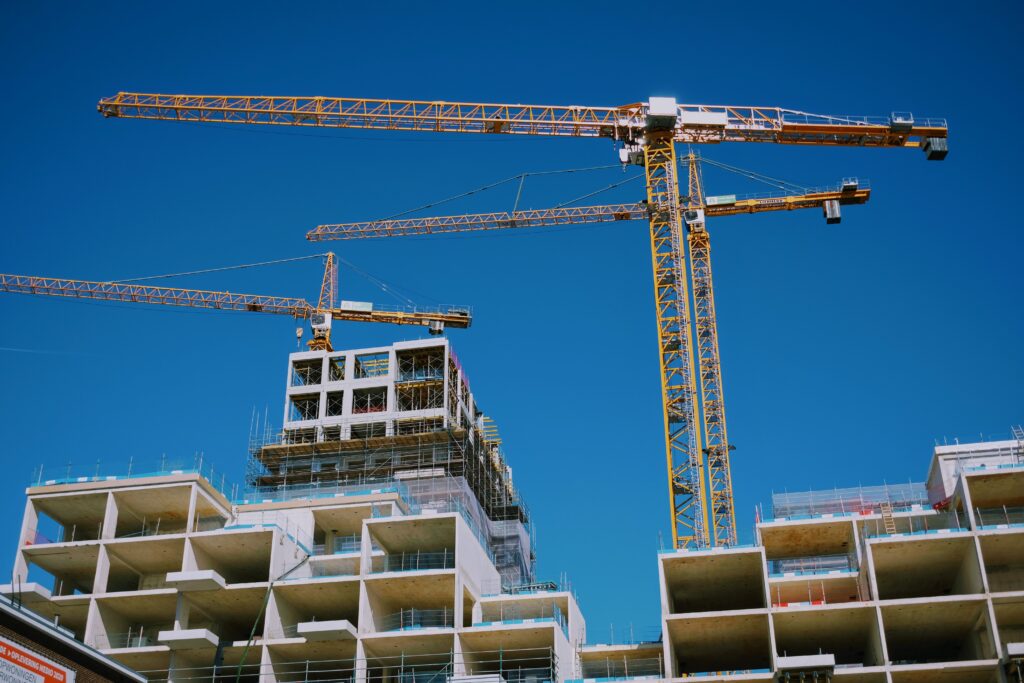2022 Construction Outlook
Looking ahead into 2022

The outlook for construction progress in 2022 is looking bright. With higher vaccination rates and easing restrictions, start up dates for new projects are abundant across the United States. While there is an abundance of projects starting, there are still problems the construction industry needs to hurdle over: higher material prices, shortages of key materials, and a labor shortage. With these obstacles, the industry will have a hard time taking advantage of the economic rebound. There is a 31% price increase in construction materials, according to the Producer Price Index. In addition to rising material costs, the labor shortage has left more then 300,000 positions vacant. Projections show Housing and Commercial construction to be above pre-pandemic levels, while Institution construction remains stagnant.
Housing Construction Outlook
After a couple years of a competitive housing market, new developments for housing could not be more in demand. Single family houses are still thriving as potential homeowners are looking to move away from dense urban areas. Multifamily housing projects are becoming a regular sight in smaller metropolitan areas. After a decline in 2020, multifamily housing is expected to outpace single family housing.
Commercial Construction Outlook
Commercial construction is expected to grow 12% in 2022 on top of a 15% gain in 2021, after facing a 20% decline in 2020. Since the start of the pandemic, warehouse construction has seen a sharp increase due to the shift in e-commerce. Online retailers were on the lookout for more warehouse space to meet demands for their products. Hot commodities at the time such as toilet paper, paper towels, and cleaning agents had been sparse on store shelves . Warehouse construction is the main contributor for rapid success in commercial projects.
Institution Building Outlook
Education
Education building projects have unknown growth due to mixed responses to keeping schools open or closed during the pandemic. These projects are awaiting for receiving funds from federal fiscal stimulus programs.
Healthcare
At the beginning of 2020, the coronavirus demanded more facilities to be made to aid overflowing hospitals. After the introduction of treatments in 2021, the outlook for medical facilities projects to slow down.
Transportation
The transportation sector is waiting for funding from the Infrastructure Bill to progress on roadways, bridges, and airports. After enduring a 21% dollar valuation decline in 2020, two airport projects in Houston, Texas and Pittsburgh, Pennsylvania are leading the industry to a 7% increase over the previous year. In 2022, another 5% increase is in sight as infrastructure funding is allocated to more airports across the country.
Manufacturing Construction Outlook
After restrictions in 2020, the manufacturing sector needs to expand in order to meet demands for goods. The pandemic caused strain on production and distribution networks, causing pause on construction. Current supply chain issues can potentially influence construction for US-based manufacturing facilities.
Non-Building Construction Outlook
Streets and Bridges
Street and bridge construction was classified as essential business during the height of the pandemic. In 2021, streets and bridges dropped 1% due to Congress not passing a replacement for the FAST Act. In 2022, the Infrastructure package plans to fund $86 billion into the sector, boosting the growth to 6%.
Environmental and Water Public Works
Changes in federal, state, and local legislation influences environmental public works construction. From the sum of $550 billion Infrastructure Investment and Jobs Act (IIJA), $55 billion of funds will be on water infrastructure, $7.6 billion in western water infrastructure, $8.2 billion for storm resilience, and $17 billion for ports and waterways. Although most of these environmental projects will take place in the future, growth projects to be 2%.
Non-Building Construction
Non-building projects include site work, pipelines. rail lines, and large sport venues without a roof. The sector is projected to grow 9% to $32 billion from 2021’s 10% decline at $28 billion. The main benefit will come from the proposed plans of railways and airport expansions.
Electric Power and Utilities
Power and utilities subsector consists of large multimillion dollar projects. Infrastructure bill will add $73 billion over the next 10 years for power grid enhancements. Moreover, some money from the storm resilience budget may also help grid-hardening projects.
Where does Spectrum come into play?
If you are looking to use quality concrete accessories on your next project, give us a call. Contact our Sales Representatives for pricing and availability. Lastly, whether it be Snapties, Coil Rod, or custom fabrication, we will exceed your spectrum for quality products and services.
Source: Dodge Construction Network
